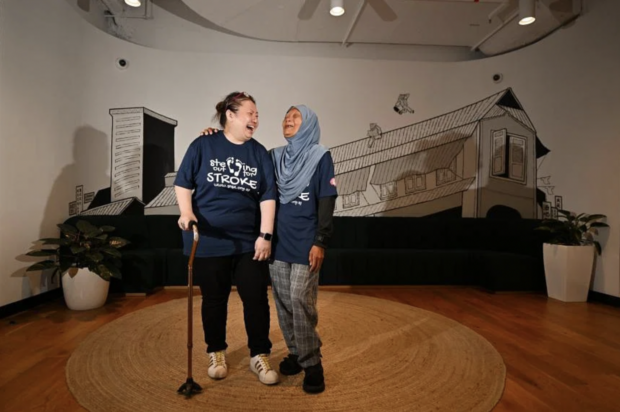Life after stroke: Survivors support other survivors to get back on track

Stroke survivors Carine Chia (left) and Atika Ahmad regained their confidence after being empowered to befriend and help other stroke survivors get their lives back on track. The Straits Times/Asia News Network
SINGAPORE – Stroke survivor Carine Chia suffered an aneurysm rupture at the age of 29 – the result of work stress and pressure from wedding preparations.
“The symptoms then were vomiting and diarrhea. It happened after lunch so my boss and colleagues, and myself as well, first thought it was food poisoning,” said the now 44-year-old former engineering assistant.
The stroke took away her independence, paralyzing her partially on the left side.
Ms Chia lost not only the use of her left arm and leg, but also her fiancé and self-esteem.
It took 15 years and a new program at the Singapore National Stroke Association (SNSA) for her to regain her confidence.
Article continues after this advertisementSaid Ms Chia: “I now join other survivors in dance and exercise classes. I even signed up as a befriender to help those who are stricken and are still recuperating at the hospital.”
Article continues after this advertisementShe is also confident enough to apply for jobs “that will result in a career”.
SNSA is taking a big step forward in stroke recovery, by placing survivors at the core of its recovery programs and empowering them to help other survivors get their lives back on track.
The association worked with the Singapore Institute of Technology (SIT), Singapore General Hospital, National Neuroscience Institute and Republic Polytechnic to create a Multi-Modal Training Programme to promote physical activity after stroke.
Associate Professor Shamala Thilarajah, president of SNSA, said: “This was co-designed with stroke survivors and caregivers to grow stroke survivors’ confidence, so that they can go to gyms, swimming pools and exercise by themselves, in pairs or in groups.
“These projects look at implementing evidence into practice in life after stroke, and how survivors can live their best lives.”
Home baker Atika Ahmad, 57, rebuilt her life after she suffered two strokes on consecutive nights in April 2021.
Because she missed a recommended four-hour window to receive intravenous treatment – she did not seek help on the first night – the strokes affected her left side, leaving her in a wheelchair.
Refusing to accept her fate, she used the outdoor exercise equipment near her housing block to regain her strength.
She searched for help online and found out about SNSA and its programs.
Today, she is walking again – a process that took about nine months – and “living my best life without depending on my family for help”.
She befriends stroke survivors at hospitals and conducts baking classes over Zoom.
Prof Thilarajah said: “By placing stroke survivors at the core of recovery programs, it enhances self-belief and adds value to existing rehabilitation services as far as functional outcomes are concerned.”
She worked on a study with Associate Professor Kwah Li Khim, director of programs (health and social sciences) at SIT, on the barriers to physical activity faced by stroke survivors, particularly the younger ones.
Prof Kwah said: “There are several nationwide public health initiatives that promote physical activity for adult Singaporeans which are largely targeted at the general population without disabilities.
“Our findings showed that stroke survivors also want to exercise regularly, but are limited by many barriers beyond their control.”
These barriers include lack of assistance from staff and programs that are not inclusive, she said.
For instance, older public swimming pools are “difficult and even scary” for stroke survivors because there is no ramp for easy access.
Under SNSA’s Sweat, Smile and Repeat program, a physiotherapist is present at two ActiveSG gyms deemed most accessible by the research team, to prescribe exercises and help stroke survivors with gym equipment.
About 50 stroke survivors not only participated in various parts of the two-year Multi-Modal Training Programme, but also contributed by answering surveys and interviews, suggesting content and recommending resources for the website Strive (strivesg.org). It is designed by and targeted at stroke survivors.
Stroke is Singapore’s fourth leading cause of death, accounting for 6.8 percent of all deaths, and the seventh leading cause of adult disability. It accounts for 4.2 percent of years of life lost due to disability.
According to the Singapore Stroke Registry Annual Report 2020, the number of stroke episodes increased from 5,890 in 2010 to 8,846 in 2020.
About four in five incidents each year were ischemic stroke, caused by a blockage that limits the blood supply to the brain, killing the brain cells.
Less common were hemorrhagic strokes, which occur when a ruptured blood vessel causes bleeding in the brain.
The report also showed that the incidence rate of stroke among those aged 40 to 49 rose from 71.9 per 100,000 population in 2010 to 96.1 in 2020.
The incidence rate for those 50 to 59 increased from 218.9 per 100,000 population in 2010 to 248.9 in 2020.
“Our work focuses on inclusivity, and we’re happy that SNSA programs enable stroke survivors to gain more confidence to stay active, and to help other stroke survivors”, said Prof Thilarajah.
RELATED STORIES